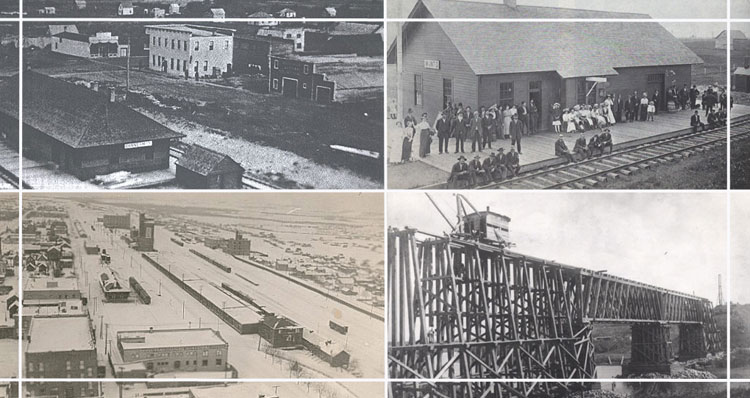

The Great Northern Line
Foreword
The Brandon,
Saskatchewan and
Hudson's Bay Railway, a subsidiary of the Great Northern Railway from
the U.S.,offered
service from Brandon to the small town of St. John's,
North Dakota where it made connections on the Great
Northern lines south to Minneapolis, east to Duluth,
and west through Montana to the coast.
The line, born as it was in the optimistic times of expansion, was
perhaps doomed from the start, but it did have its impact for a few
short decades on several communites south of Brandon, and in a limited
way, on the city itself.

Where is Bunclody?
I’m pretty
sure that the first time I ever heard of Bunclody, someone was
making fun of the name. It was Vince Dodds, the morning man on our
local
(Brandon) radio station, and he had a running bit involving checking in
on
the exploits of the Bunclody Bridge Marching Band. Something like that,
a
gentle comment about small town life at a time when small towns were
rapidly
disappearing. It's a pleasant name, Irish in origin, and, yes, perhaps
a
bit fanciful when compared to the nearby communities - with their
stolid,
sensible names like Hayfield, Carroll, or Brandon.
In
any case, the name must have impressed me enough to remember it, but
not
enough to prompt a visit for many years.
It
wasn’t until decades later while scouting canoe trips on the
Souris River
that I made my first visit. Bridges are all-important when planning
short
river excursions, that's where one finds the most user-friendly access
to
the river, and I soon became acquainted with all such points in western
Manitoba.
What
a treat it was to finally see the place. Yes, you could see why
the
radio jokester had singled it out. By the sixties many former prairie
villages
were that in name only. It was as if we were reluctant to take down the
road
signs, change the road maps and admit defeat. Bunclody turned out to be
just
a shady roadside park nestled alongside a gravel road near the river
where
it brushed against the southern rim of a wide valley. It barely
qualified
as a ghost town! At first glance only the two cairns in the park gave
evidence
of any past settlement.
It's
funny how you can miss things, and odd that in driving through the
valley
I didn't notice the way the road southward up out of the valley cut
through
a narrow ridge running along the hillside. Not so odd perhaps that on
several
trips up the gentle slope northwards from the river, I failed to notice
the
signs of a substantial embankment approaching the river a kilometre to
the
east; unmistakable evidence of a railway line. It's obvious if you know
what
you're looking for, but a quite unobtrusive element of the rolling
valley
landform if you don't. And its quite understandable that later as I
paddled
downstream from Souris to where our vehicle was waiting by the Bunclody
Bridge,
I failed to notice the same embankment curtailed on either side of the
river.
The constant erosion of a riverbank over a few decades had erased much
of
the evidence.
 Can
you spot the rail
line
embankment, along the
Can
you spot the rail
line
embankment, along the
centre of this photo?
So what I missed
seeing in my first visits to Bunclody was the evidence of a rail line
that had once crossed the river at that point. It was another few years
before a friend from the area told me about the rail line,
and took me out to a neighbour's farm to see the huge
concrete culvert at the base of what looked like a dam across a steep
ravine. It is now almost plugged with debris, but he remembered playing
in it as a child, taking the dare to pass through its 100 metre length
to the other side. What looks like a dam is actually a bridge,
timber-framed then stabilized by earth fill that hides the framework
– a common way of crossing the deep cuts running towards the
Souris River. On another trip to the area my wife and I climbed the cut
bank along the roadside and followed the overgrown rail-line path,
first south for a few kilometres, and then north for a ways until it
abruptly ended, leaving us looking across the Souris River to where it
continued on the other side. Knowing that, it was easy to recognize the
signs in the river below, a small island that once served as a footing
the center support for the bridge.
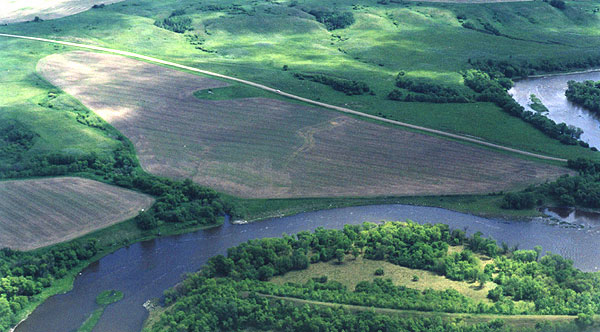
The old line
is quite visible from the air.
The elevator and station were about half a kilometre to the right.
And that's how I
first
learned about the oddly-named Brandon, Saskatchewan and Hudson's Bay
Railway and its American parent company the famous Great Northern Railway.
We all know about the
importance of the railway in the development of the
west. Those two venerable Canadian institutions; Pierre Berton and the
CBC,
have made it hard to escape the role the building of the C.P.R. played
in
our history. Railways have been romanticized, eulogized, and demonized,
but
never ignored.
Equally
true however, is the fact that in much of rural Manitoba, and
across
the prairies, the rails are being abandoned, torn up and inevitably
forgotten.
The railway boom lasted only a few short decades before retrenchment
began.
For rural communities the presence of a rail link went from being
indispensable
to being inconsequential in a less than forty years. We had barely
completed
criss-crossing the land with lines when we began taking them up.
Sometimes
we built too many.
That
may well be the case with the much-anticipated route from Brandon
south
to the U.S. Border, seen at the time as a forward-thinking link with
the
extensive Great Northern Railway. But to rural people in southern
Manitoba
at the end of the 19th century, there couldn’t be too many rail
lines. Many
of the first settlers had waited patiently for the first lines, which
in
many cases were delayed by the infamous “monopoly clause”
in the governments
deal with the syndicate that built the CPR. Even after the
Greenway
government was able to end the 20-year monopoly in 1888, many farmers
still
had a long haul to get their grain to the nearest elevator and many
complaints
about the service they received, specifically6 the availability of an
adequate
number of rail cars in peak periods. Anything that would reduce the
length
of those trips, plus add an element of badly-needed competition was
welcome.
(Minnedosa Telegram Nov. 17, 1906
It
wasn’t just farmers who wanted this railway. There was a lot
of boosterism
associated with railway building. There was profit to be made in the
building
of the infrastructure and in the establishment of related services. The
arrival
of a rail link seemed to secure the fortunes of any small settlement
and
enhance the prospects of existing towns. This line was destined for a
short
life span, but in that short time it certainly did provide a much-need
service,
and made quite an impact along its route.
As
early as 1898 Brandon's City Council was hearing proposals and
rumours
of proposals for a north-south line that would allow a direct link with
the
Great Northern Railway in North Dakota.[1] Such a line would provide a
direct
link to Minneapolis, the economic heart of the American mid-west.
Brandon,
having established itself early as an important stop on the CPR, was
facing
the possibility of being bypassed by other east-west lines and was
determined
to maintain its position by capturing a north-south line.
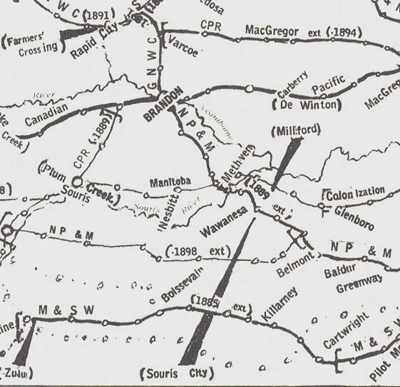
Rail
lines as of 1900
The
whole
operation
reflected the optimism of the times and the fact that
no one could predict the path development would take on the Prairies.
In
particular, no one predicted the impact that the newly-invented
automobile
would have on transportation, and that it would quickly render
passenger
service unprofitable. Perhaps the most interesting, and perhaps
slightly
ironic aspect of the unknowable future was that the productivity
allowed
by better movement of farm products allowed farmers to expand their
holdings,
in turn sowing the first seeds of the rural depopulation that would be
a
contributing factor in the demise of rail service.
But that was all in the
future. The
present required growth and expansion,
all facilitated by better transportation.
While the first plans
failed to
materialize, by 1903
the seeds of a workable
proposal were being sown and spurred on by prominent local businessmen.
Brandon's
own Clifford Sifton, Minister of the Interior, was likely a factor in
the
parliamentary approval for a charter for a line from the U.S. border to
The
Pas. That charter lapsed and had to be renewed in 1905, this time with
the
behind-the-scenes support of American J.J. (Jim) Hill of the Great
Northern
line for an operation to be known as "The Brandon, Saskatchewan and
Hudson
Bay Railway." [2] That catchy title certainly reflected the frontier
optimism
of the age of railway expansion. The first and, as it turned out, only
stage
of the project was to be a 115 kilometre track to a border crossing
south
of Boissevain where it would continue to connect with the Great
Northern's
well established U.S. network. It turns out that Hill had no intention
of
heading either to Saskatchewan or to Hudson Bay under Great Northern
ownership.
[3]
There were several issues that the
city
fathers had to confront. Of course
the C.P.R. objected, that was to be expected. Some objected on the
grounds
that it was an American intrusion into the market that would divert
trade
from Canadian routes. Others had reservations concerning the ownership
of
the Great Northern. Jim Hill had been invol
ved
in the original
development
of the C.P.R. and at one time had hoped that the eastern portion of the
new
line would pass beneath the great lakes through the U.S., facilitating
easy
links with his other holding and providing the basis for a North
American
rail empire. When the decision was made for an all-Canadian route he
withdrew
from the project. Some said his main motivation in establishing this
North
South link was to get back at the C.P.R. It is more likely that Hill
simple
wanted to expand his operations in a most logical fashion with another
Canadian
link. [4]
There was a necessary and habitual
attempt at
secrecy, mainly to forestall
land speculation that would drive up the prices of required stations
and
related property, and also because of local opposition to the American
ownership.
The local promoters tried to maintain pretense at first, to a Canadian
component
to the corporation, but it turned out to be totally a Great Northern
operation.
After witnessing the orgy of land speculation and townsite swindles
that
preceded the C.P.R. on its pathway west, the railways had learned a
lesson
and regularly went to such lengths as to develop secret telegraph
codes.
Thus a communication from R.I. Farrington to Louis Hill on August 7,
1905
read: "Duchy Jame Alfred anything dwindle about reasoning for brusher
outlive
loquacious." Translated it meant, "Do you wish anything done about rail
for
Brandon line" [5]
Most
Brandonites
were all for the new line. And those along the proposed
route could see the possibilities. For many farmers it would cut the
distance
they had to haul grain. Aside from the historical reason fro distrust
of
the CPR, there had been some widespread dissatisfaction with that
railway,
amid concern about inefficient grain handling and allegations of
collusion
with elevator companies to the detriment of producers. For all rural
people
along the proposed line it mean greatly increased options for
convenient
travel.
Once the deal was struck the line was
started
without delay, beginning
in
1905, and decisions were made quickly regarding the route and placement
of
stations. Despite the best effort of the rival lines to stall the
establishments
of the necessary crossings at Wakopa, Boissevain and Minto, the line
worked
its way northward at an astonishing pace. Rights of way were purchased.
Established
communities of the Boissevain, Minto, and, of course Brandon would be
on
the route. New sites of Bannerman, Bunclody, Hayfield and Heaslip were
surveyed,
although not all developed into villages. A deal was struck with McCabe
Elevators
for grain handling facilities and Great Northern cash was provided up
front
to build the twelve facilities. Even the sites of Fairburn, Alcester,
Griffin,
Healip, McKelvie and Roseland would have elevators but even in those
optimistic
times villages were not anticipated.
While stations were located at most of
the villages
even stops that
didn't
evolve into real villages got waiting rooms complete with pot-bellied
stoves.
Stops like Beverly (originally called Webster) and Hebron, closely
spaced
between Bunclody and Hayfield, and known as "sidings", got loading
platforms.
Several sites had dwellings for section foremen and bunkhouses for
crew.
Water towers, a vital part of the infrastructure in the days of the
steam
locomotives, were closely spaced on this line with structures at
Bannerman,
Boissevain, Minto, the Souris River Crossing near Bunclody, Hayfield
and
Brandon. Each had a pumping manager in charge. Crucial to the whole
operation
was a 30 year contract to carry the mail. Post offices were established
along
the line or in several cases moved to be closer to the line. [6]
By
1906 the trains were running, bringing an immediate benefit to local
farmers,
improved mail delivery, easier access to both Brandon and the point in
the
US, and a much improved distribution of consumer good into the rural
area.
According to Great Northern records, the
line ended
up costing
$2547281.37.
[7] That price was perhaps a little steeper than they had intended. The
CPR
competed for contractors, offering work on its own lines and thus
boosting
prices. The GN countered by offering local farmers work on the easier
grades
with contracts going out in 1906. A story in the Boissevain Record
insisted
that between three and four thousand men were employed in that year. It
was
the only common carrier railway line ever build in Manitoba with no
public
subsidy of land or money, in fact, it often paid inflated prices for
land.
[8] The extra cost was the first in a series of circumstances that
limited
the profitability of the line.
A Ride on the GN Line
Let's hop on
board as
the train departs from St. John's, North Dakota, just
a few kilometers south on the Manitoba / US border where connections
could
be made to points south (Minneapolis) and points west on the Great
Northern
Line.
In
charge is
St.
John local, Charlie Bryant, long time conductor, well-known
to folks all along the line, a man who wouldn't hesitate to make an
unscheduled
stop or other accommodation for a good customer.
The line stretches across flat
prairie,
broken here and there by a slough
ringed by low willows, a low bunch of aspens in the corner of a fenced
pasture,
and a farmyard with the beginnings of a shelterbelt. To the left
(west) in
the distance is the outline of Turtle Mountain, low and thickly
wooded
with oak and aspen. But straight ahead lies an uneventful horizon.
Before
long
we're
at the border and four
kilometers past that is the newly-founded village of Bannerman, a place
that
owes its existence solely to the railway.
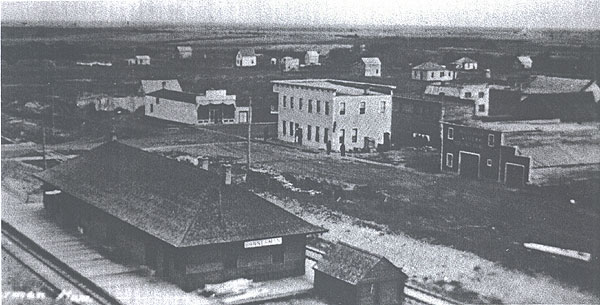
Bannerman
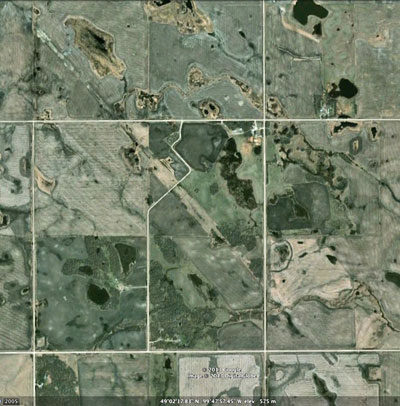
The
site is still quite visible on Google Earth while very little evicence
remains on the ground.
Of all the newly
created and boosted villages along the line, the rise and fall
of Bannerman was the most dramatic. The new rail line. coming as it did
from
our southern neighbour, required a Port of Entry, naturally the first
stop
after a border crossing. A spot on NE 15-1-18 was suitable and
available.
Settlement in the area, just three kilometres from the US border dates
from
around 1880 when James Henderson Sr. was the first settler to file in
this
vicinity. In 1905 as line approached, the town of Bannerman sprang into
existence
with excitement and a sense of possibility, the first and only port of
entry
by rail west of Emerson in Manitoba. The Manitoba Telegram
ventured
the opinion that it would become “ a good live town” and
that “busy little
centres will be established” at all the townsite points along the
route.
[9]
There
was of course a rush to build homes, businesses and an elevator
and
Bannerman quickly developed a boomtown atmosphere. A hotel with large
dining
room and bar encouraged visitors especially during those years when the
prohibitionists
won the almost annual battle with the temperance folks. During the
prohibition
years the bar became a dance hall. Other buildings included a feed and
livery
barn with sleigh and buggy for hire, a lumber yard, pool room and
barbershop,
a store and post office, a blacksmith shop, harness and shoe repair
shop.
Soon a second grocery store and additional blacksmith shop was needed,
and
two dealerships for the fast growing farm implement business.
The station's status
as a port of entry meant that station had two
offices,
one for the railroad agent and one for the Customs and Immigration
officer.
These duties and responsibilities required other facilities and
enhanced
the status of the town. A detention house was soon added nearby for
those
who were not granted entry, and had to wait overnight for the train
back.
A quarantine barn was needed as all livestock was held overnight for
inspection.
To north of station were two section houses and a water tank.
Another added responsibility was
controlling the flow of alcohol as
different
and changing liquor laws always seemed to keep make smuggling a
worthwhile
venture. Agents patrolled the border in the area. Then as now border
security
was an important responsibility. Magistrate John Balfour, aided
by
town cop Sam Balfour kept the peace locally.
Each
year the circus of the Royal Canadian Shows came by the Great
Northern
to entertain at Brandon summer fair. Customs agents went to Devil's
Lake
to start inspection of the many passenger cars and the inspection was
completed
at Bannerman.
A
hotel with large dining room and bar appeared, but bar closed with
prohibition
and the building became to a dance hall. Other buildings included a
feed
and livery barn with sleigh and buggy for hire, lumber yard, pool room
and
barbershop, store and post office, blacksmith shop, harness and shoe
repair
shop. [10]
On to Desford and Fairburn...
Pulling
out of Bannerman, we are just nicely getting up to speed when
another
fledgling village appears on the horizon. But we pass by it to the
west.
The village of Wakopa, the first in the southwest corner of Manitoba
is,
a well-known fixture on the rival CN line that we are about to cross.
But
not for long.
Wakopa
had its beginnings as a stopping place on the Boundary
Commission
Trail, that well-rutted trail first etched by the expedition sent in
the
1870's to survey and describe the border region from eastern Manitoba
to
the Rockies. The store established there by a Mr. Lariviere who served
those
hardy early settlers who arrived before the big rush of the 1880's and
the
site continued to be a landmark and supply depot until the arrival of
the
a spur line branching off of a more northern line at Greenway a
kilometer
to the north. The town moved to the line and continued, enhanced by the
new
rail service, but limited by competition from the Great Northern line
passing
it just a kilometer or so west. Even in boom times this region could
only
support so many towns! [11]
With Wakopa bypassed
we soon pull in to in an even smaller place!
This village also sprang up overnight as it
were,
although an earlier post
office and store were in place to the west and had to be relocated. But
it
lacks Bannerman's boom-town vibe, just a station an elevators and a few
scattered
buildings.
Rail lines are a vital service to any
community. To
the owners, they are
a business like any other: they will survive if they are competitive.
On
the prairies, that means competing for grain delivery. To do so
elevators
or loading platforms have to be spaced closely enough to ensure that
farmers
will choose them over competitors. The Desford community began in the
late
1870's along the Old Commission Trail about 12 kilometres
south-southwest
of Boissevain, and was, like Wakopa, one of the first trading centres
in
the area.
In those first days of settlement, 1878 and
79,
settlers came by the Boundary
Commission trail from Emerson. By 1880 the preferred route was by way
of
the Assiniboine River to Millford, then south to Langvale and via the
Rowland
Trail to the Turtle Mountain area. The first stores in the area were at
Desford,
Wakopa and Waubeesh. The first general store and post office in "Old
Desford"
was owned by E. Nichol and Son.
Fred Johnston, and early resident of
Boissevain,
before the town even developed,
recalls the choice in 1884 between shopping at (Old) Desford and
Rowland
(16km NE). Another pioneer recalls Sunday Church service in the Jimmie
Burgess
home at "Old Desford". But as with so many of the first settlements,
the
location had to be reconsidered when the railways came. For Desford the
change
began in 1906. First the CN line was extended through Wakopa, Adelpha
and
Horton, just narrowly bypassing Desford, The that same year The Great
Northern
Railway bypassed to the east and a new town started to grow on that
line
about six kilometres away.
The store at
Adelpha, owned by Mr. Crummer,
was
moved four miles to Desford.
They used sixteen team of horses to drag it and the path was still
visible
in the 1970's. In no time a McCabe elevator was built. Next came the
section
house, a few residences, a station, and a bunkhouse . Qualified help
was
in short supply and the station master had to imported from the U.S.
Both
Anglican and United Churches followed, and other buildings included a
large
storehouse and garage, an oil station, and a blacksmith shop. The
population
exploded to near thirty and a community hall was deemed necessary. [12]

A cairn marks the location of Desford - all traces are gone.
A
few kilometres out of Desford
we come
to Fairburn.
These "sidings" as they
were called were put in place to accommodate local farmers, and were
never
intended to become villages.
It
may seem odd to the modern
urban-dweller,
that a
place like Fairburn rate
identification on a map, being no more than a lone elevator on the open
prairie.
One has to understand that in the early years of the settlement era
(1878
to 1885) few towns as we know them existed. When settlers moved in, a
neighbourhood
would be identified in government records, and thus on maps, by its
post
office (usually established in the home of a settler) and it's name
became
the community's identity. For instance in a map by DeVille dated 1883
Fairburne
(original spelling), Desford, Adelpha, Alcester, Wakopa and Hayfield
are
identified, while Boissevain, Killarney and Minto have yet to may an
appearance.
[13]
A
quick stop and we're off to the bustling commercial centre of the
region.
Boissevain
By
1906 Boissevain was already a
well-established town on a busy C.P.R.
east-west line. It origins date to 1885 when, in anticipation of the
arrival of the tracks, several settlers congregated on the site.
One of those was George Morton, a well-established businessman with
several ventures in the region, who moved his general store
building from the
earlier settlement of Wabeesh (near present-day Whitewater) which was
to be bypassed. By 1886, with the tracks in place, the little town
inlcuded a grain-loading platform, a post office, two more general
stores, a few boarding houses, two hotels, a blacksmith and a grain
warehouse. Originally known as Cherry Creek the name Boissevain
was chosen to honour A.A. Boissevain, a Dutch financier whose
investment had helped finance the C.P.R. I guess one could say that
really
makes Boissevain a "railroad" town. In a way Boissevain
brought as much to the GN line as the line brought to the community.
It was
the first link with the established Canadian routes, expanding the
opportunities
for each line and for the people of the area.
Until 2008 Boissevain had the
distinction of
being the home to the only surviving
GN station, which saw decades of service as a Highways Department
garage.
There is some
evidence that the station
also featured a garage complete with track so that the engine could be
brought
in for service. Unfortunately, when no use for the building could be
found, the costs
of preservation dictated that the building be torn down, but the
stayionmaster's house still exists as a concrete reminder of the Great
Northern's presence.
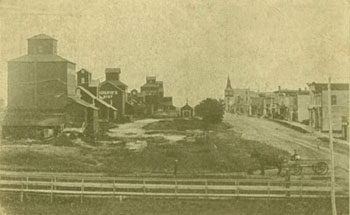
Boissevain
in 1908.
Elevators
along the East-West CN line, The GN line would have run left to
right near the bottom of this image. The station was
a few blocks to the right.
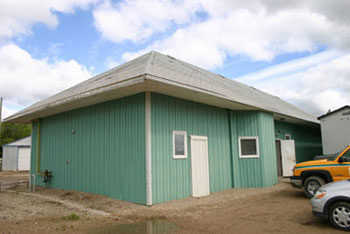
The
GN Station at Boissevain was refitted
for use by the Highways Department (2007)
To an established
centre one immediate benefit was the work available in
construction. There were contracts and jobs available, and the lucky
landowners
who found their farms on the right of way no doubt enjoyed the
compensation.
Even when the line was surveyed right through a house as it was to a
Mr.
Henderson, he happily moved. [14]
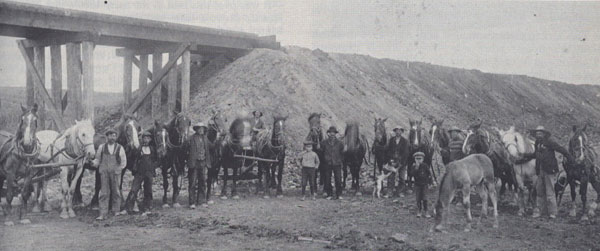
A
construction
gang
near Minto.
After a short stop
the whistle blows and we're off again, on our way straight
north to Minto, with a stop at Alcester, another siding and elevator
that
didn't become a town. Alcester had existed as a post office and as one
of
the original "districts" of the settlement era, and the improved
communication
offered by the rail line probably hastened its demise. The post office
closed
in 1907. It was just too close to Boissevain and Minto.
Minto
Although
the
surrounding area was well settled, Minto wasn't established
until the Canadian Northern line in came through in 1898 and a village
sprouted
on the northeastern corner of Section 19-5-10. When a few years later
this
new line, with its links to points north and south, was indeed a shot
in
the arm. The local history is full of examples indicating how happy the
residents
were to get this additional service, allowing convenient day trips to
Brandon
the main trading centre of Western Manitoba.
When
that first train
came through in June of 1906, with daily mail freight
and passenger service to Brandon, life changed. For that period of a
few
decades, the brief but important prairie railway age, there were four
express
trains daily, with the CN going east and west and the GN north and
south.
Added to that was the economic spin-off from the two new elevators and
coal
shed built to serve the line. It was an amazing leap forward from the
pioneer
times when the horse and buggy was luxury travel and people thought
nothing
of walking fifty miles if it had to be done.
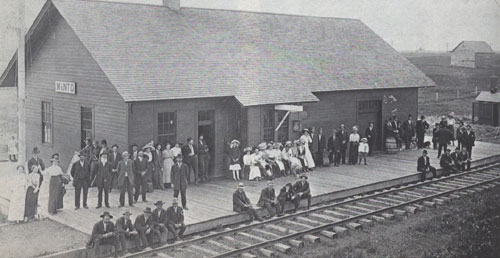
Eagerly
awaiting the train for an
excursion
to Brandon Fair, 1917
It was exciting,
as
Sylvia
Sprott indicates in her memoir in the Minto History;
"A trip to Brandon on the Great Northern train was indeed an event to
remember."
Many adventures are associated with the railway are reported in the
local
history. In some winters heavy snowfalls interfered with the schedule.
Snow
clearing equipment wasn't as powerful and fast as it is today, and the
portions
of the line called cuts, where excavation had been used to smooth a
grade
into a valley or over a hill, filled in quickly in a storm. In 1916
heavy
snow cancelled trains for six weeks. In March 16 of 1920 a blizzard
brought
10-15 feet of snow, closed both lines for a week.
And there were other perils. A
daughter
of John
MacDonald reports that, "One
year a spark from the Great Northern train started a fire that burned
most
of the crop, all the buildings, and a great deal of hay." [15]

The
GN line
crossed the CN
line at Minto, a tower overlooked the crossing.

Heaslip
Before the
arrival
of the railway the settlement in the Minto area was defined
by a series or rural Post Offices and the pre-railway cart-trails,
rather
than by a village centre. Samuel A. Heaslip (Pronounced hays-lip) came
from
Ontario in 1881 and homesteaded 32-5-19. just south of the Souris River
and
close to an established route between Brandon and points south. Mrs
Heaslip
was first white woman in district that soon bore their name. Mr.
Heaslip
drove mail after railway came to Brandon in 82. The trail crossed
Souris
at Sheppard's Ferry, passed the Heaslip's home, on to Sheppardvillle at
3-5-20,
then to the Turtle Mountain area. The route soon became known as the
Heaslip
Trail. The Heaslips well known and their home was a stopping place on
the
trial to Brandon. Mrs. Heaslip, widely known as a kind motherly person,
served
as deputy post mistress of the first Post Office of the district.
It
got another big boost when the Great Northern began operations in
1906
and the Heaslip community also developed into the beginnings of a
village,
with a station and general store. At the village's apex in the 1920's
the
store was bought by Otis Vig who moved his family from Bannerman to
these
greener pastures. The direct rail line came in handy for the moving of
household
effects and the family was soon comfortably established in the
residence
above the store, across the tracks from the McCabe Elevator and the one
other
residence, that of Heman Bales the grain buyer, and less than a
kilometer
south of the station and loading platform. Mr. Vig expanded, opening a
Case
Implement Dealership.
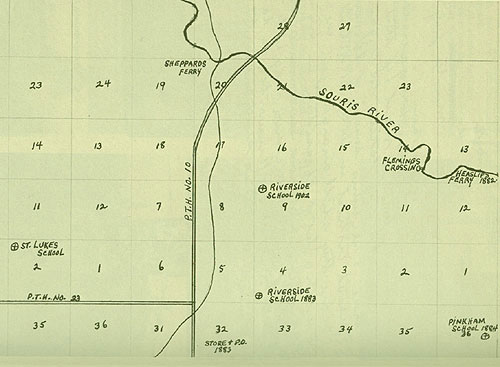
Main routes, before and after the
days
of
the railway.
During this time the
bridge we now call the Old Riverside Bridge was built,
changing the road transportation patterns substantially. Until this
bridge
was built the main road from Brandon south followed the rail line south
from
Brandon, through Hayfield and Bunclody. In the 20's what we know as
Highway#10
was developed and became the main route bypassing those villages. The
age
of the auto was upon us and as the railway had dictated which townsites
survived
in earlier times, the highway was now the key.
Perhaps seeing this
writing on the wall, Mr. Vig sold his store in 1930 and
soon relocated to Brandon. Even had the railways continued to operate,
as
roads improved and cars became popular, Healsip was just one town too
many
on a busy highway. [16]

Heaslip
from the
south
Bunclody
Pulling out of the Heaslip Station the track
bends slightly westward and
passengers who look to the east will see the first real change in
scenery.
The landscape of Southwestern Manitoba is
dominated, perhaps defined, by
the Souris Plains, a wide expanse of relatively flat country stretching
from
the base of the Turtle Mountains west and southwards towards the Souris
River
Valley. Early settlers speak of climbing out of that valley at
Millford,
near where Treesbank is today, and noting the Turtle Mountains to the
distant
south. That's how flat the plains are, it's a distance of nearly 100
kilometres
and to call those turtle-shaped hills mountains was a bit of a stretch.
Today
a drive from Minto west to Elgin, essentially through the centre of the
Souris
Plains, gives one and understanding of the term "wide open spaces".
And then, as now, the traveler new to the
area, and
on a trek from Boissevain
northwards to Brandon, whether on the rutted ox-cart path known as the
Heaslip
trail, or on the smoothly paved Highway 10, might be surprised when,
out
of nowhere, appears the valley of the Souris, a kilometer wide / 70
metre
deep channel cut over ten thousand years ago as the last of the glacial
lakes
drained.
Scenic it may well be, but to the railroad
builder
it holds no romantic charms.
It is an obstacle to be crossed. A challenge perhaps, a nuisance,
definitely.
When building a railway over hills or through
valleys it is often advisable
to the travel a few extra kilometers to avoid a steep grade and the
expensive
construction costs associated with difficult terrain. Trains don't do
well
on hills, and keeping the grade or slope of the track as gentle as
possible
is a priority in construction. As far as the prairies go, the northern
portion
of the Souris River valley is a major challenge. The surveyors for the
Great
Northern had rejected a crossing straight south of Minto where the
valley
is both deep and wide, and had selected a site near the hamlet of
Bunclody
where the southern lip of the valley, although steep, brushed right up
against
the stream, while the gentle slope on the north side could be crossed
with
a modest embankment. To get there, the line bends westward at Heaslip,
following
the curve of the river and crossing a series of deep cuts where ravines
enter
the valley.
This was the major construction
site of the whole
project. Three work camps
were quickly set up, one at the deep ravine 3 kilometres south of the
crossing,
one at the townsite on the south side of the river where the station
house
was built, and one on the north side of the river. Each camp had a
steam
shovel, (“of the largest size”) modern technology not
available a mere 25
years earlier when the CPR crossed Manitoba. Dinky engines were used to
haul
and dump cars as the grade was built up. It was a major engineering
project
undertaken by, “one of the largest railway outfits in
America.” [17]
The ravines south of the river were crossed by
building temporary trestles
and dumping fill to create a road-level earthen dam, complete with huge
pipes
designed to let the runoff through. The pipes soon broke and had to be
replaced
with concrete tunnels two metres square - still quite visible
today,
although somewhat clogged with rubble. One resident told me about
boyhood
adventures that included a dare to go through the tunnel.

Crossing
a
ravine
between
Heaslip and
Bunclody
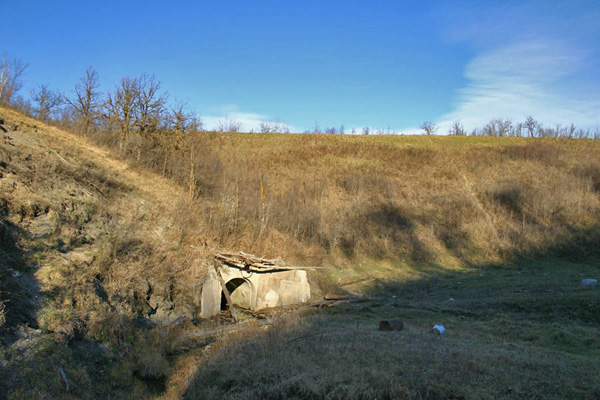
The site in 2016
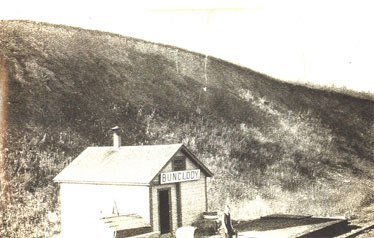
Bunclody
Station
The bridge
over the
Souris was
the
biggest
undertaking. The span was 132m. long and 26m. high. Timber for the
trestles,
including 30 metre long cedar pilings had to be hauled from the CN Rail
stop at Carroll, about 8 kilometres away.
The elevator
and station, along with a
bunkhouse for some of the the many full time employees required to
maintain the line, were situated halfway up the southern ridge of the
valley, half a kilometer from the bridge. The water tank was on the far
side of the river slightly north of the bridge, with pumps and pipes to
draw river water for the steam engines.
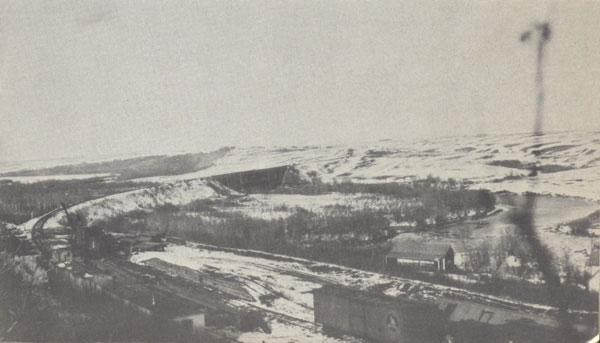
Taken from the hill, SE of
the
elevator.
Preparing the grade
towards
the crossing of the Souris near Bunclody.

Bridge construction
Today,
standing on the old rail line where
it abruptly ends atop a steep cliff at the river's edge, having
followed it from that site through a pasture as it curved towards the
former crossing, one can look northward across the river and see one of
the few remaining obvious signs of the old line. Directly below you, in
the centre of the river is a small gravel bar, once the base of the
central bridge support, and across the river where the valley wall
slopes gently away from the water's edge, is the high embankment built
to carry the line gently across the wide valley.
From
the day
that first train came through
on June of 1906, there were two passenger trains per day, going
south
at 8 a.m. and north at 7 p.m., six days a week. The freight train ran
every day, south on one day, north the next, except Sunday. If one were
to stop at the station and swap railway stories with the locals you'd
likely hear about the time in 1916 when a runaway engine from Minto
stopped at Bunclody. Later in the day the Engineer and fireman came
walking down the track looking for the runaway. It happened when the
engineer thought that a switch was closed at Minto and he and fireman
jumped ship, so to speak. A closed switch would create a dangerous
derailment. It turned out that the switch was in place.
This was not
as uncommon
an
event as one
might expect, there was another incident a year or so later when a
boxcar got away from the Heaslip siding and rolled on downhill to
Bunclody.
Or perhaps
you'd hear
about
the morning
in
1914 when three horses wandered onto the right-of-way. They were
frightened by the approach of the frieight train and ran ahead of it to
the bridge; where they jumped off and met their deaths on the frozen
river 26 metres below.
Here,
as at
other stops on the line, you would
certainly hear the winter tales.
Snow
was the
winter enemy. Trains were stuck
often in cuts sometimes for a considerable stay! The Bunclody History
relates the story of a train stuck in the Hebron cut from November
until March. That was in the first year of operation and it was a work
train which had its own kitchen so the crew lived there for the winter.
It was on the farm of a Mr. Roger, who obliged by hauling them water.
Was this during construction perhaps, because no mentions is made
anywhere of that sort of interruption in service?
Apparently
four metre feet deep drifts in cuts
caused stoppages of up to six weeks in the winter of 1915-16.
Each
winter had its share of such events. In February of 1923 a blizzard
blocked the line from Minto to Brandon for three weeks. Clearing the
snow was a big job, without the advantage of today's high-powered
graders and bulldozers.
The
worst spot
was the Wilson Cut two
kilometres north of Heaslip, the site of an adventure in March of 1923.
A train with two engines and a snowplow was stuck and snow drifted in
half-way up the windows. In such cases, neighboring farmers were often
called upon to
help out and the presumably patient passengers relied on the kindness
of strangers so-to-speak. Supplies were brought from the Heaslip store
and lunch was served.

Hebron
and Griffin
Siding
Sometimes
plans change. On paper it looked like Hayfield was the next logical
station with the potential to become a village. Sidings and/or loading
platforms would be sufficient for the two stops between Bunclody and
that newly established site.
Those
two stops would be Beverly and
Hebron.
Hebron
had
been
an
identifiable
community for some time, with the school as the focal point. Between
the Beverly and Hebron sidings the line was crossed by a busy east-west
CP line connecting Winnipeg and Regina by a route parallel with the
main line. These crossing were referred to as "diamonds" and required
staffing to set the switches. Slightly west of the diamond at Newstead,
a rival company established an elevator and before long the McCabe Co.
and their Great Northern allies determined that they too needed and
elevator at the crossing to compete. This meant having an unprecedented
four elevators on a mere 12 kilometre stretch. It also meant that
Hayfield which had a full station as opposed to a small shelter, would
be downgraded. Its station was moved to the Diamond, named
Griffin. Later it was moved again and served the remainder of its
days as a community hall in the Riverside district a few kilomtres to
the south west. Hayfield received the shelter that had been at Hebron.

Hebron School
From
Bunclody
the line angles a bit west to
skirt the western rim of the Brandon Hills, and at the western foot of
those hills is the hamlet of Hayfield.
Hayfield
is on the early maps, and had a
post office and school serving a defined region. Although surveyed as a
town during the planning of the line, it never did contain much more
than the station, a general store, a hall and a few houses. Today as a
traveler going south
from Brandon who turns westward off of #10 Highway and proceeds
down Hayfield Road will pass the unmarked and unrecognizable townsite.
[19]
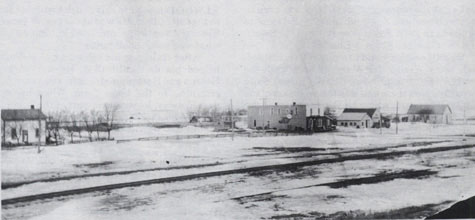
Downtown
Hayfield
From
there
the rails
continued straight north
through McKelvie and Roseland before angling eastward into Brandon.

An on to Brandon....
From Hayfield the route takes us
through a siding at McKelvie and the tiny village of Roseland then in
to Brandon.
Brandoin railway historian,
Lawrence Stuckey, remembered
transfers between
the CN
and the Great Northern
on a track set up on what is now 25th street. He also remembered going
down
the main line, which entered Brandon from the west running just south
of Pacific Avenue. The colourful refrigerator cars
carrying
fruit from various American companies especially caught his eye. No
evidence
remains of the wye about 5 kilometres west of the station where
passenger
trains turned around to back into the station, nor of the "diamond
crossing"
over the CNR line a kilometer south of that and the tower overlooking
it.
There was a three-stall engine house and turntable for maintenance near
26th
and Pacific, a station near 11th and Pacific, and a block-long freight
shed
a few blocks west of that. [20]
The Great Northern
contributed substantially to Brandon’s economic makeup.
A promotional publication entitled “Brandon in 1913” boasts
that ”Brandon
has direct connection with the great railway systems of the United
States…”
and goes on to mention that the railway has a charter to build on the
The
Pas and Hudson’s Bay. [21]
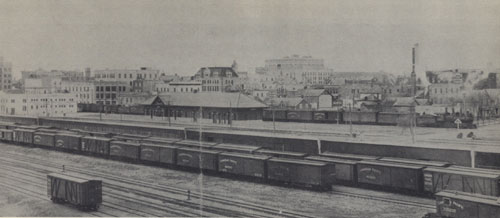 Brandon
Station, train ready to depart. They were backed in to the
station area.
Brandon
Station, train ready to depart. They were backed in to the
station area.
It wasn’t without
at least some opposition, but that was mainly related to
issues about the appropriation or re-location of some homes and
buildings
along the route as the rails were pushed into the city. [22]
But the ongoing
battle between the C.P.R. and all
forms of competition was
not over. The C.P.R. responded with a new station and an expansion in
Brandon
that some though was partially intended to ensure “for all time
the exclusion
of any other railway lines along this throughfare such as the
continuation
of the Great Northern through the city.” [23]

The
End of The Line
By
late 20's it was
apparent that big profits for the company would never
materialize. The line had been built into an area that was already
served
by east-west lines. Unlike the original CPR lines, the owners had been
prevented
from making large start-up profits from the establishment of towns and
the
grants of land often associated with a new line. With the defeat of
Laurier
in 1911, the hope of a reciprocity agreement with the US, which would
have
increased north-south freight, was effectively over. The population had
reached
its peak and the car was establishing itself as the mode of choice for
personal
transportation.
This possibility of
reciprocity
had
encouraged the expansion of the Great
Northern and some speculated that it would lead to a large portion of
the
grain harvest being transported through the U.S. Needles to say, there
were
many Canadians opposed to reciprocity for that very reason. The Portage
La
Prairie Weekly noted that “The Great Northern Railway…has
no lees than seventeen
different lines operating between Canada and the country over the
border…:
and could see that much business would go that way. [24] That was
a
pretty good argument against Reciprocity from a western point of view.
Another force at play was the growth of the
cooperative initiative that became
The Manitoba Pool Elevators.
"Part of the problem … was that farmers were
prepared to support the Manitoba
Pool, even at a financial cost to themselves." McCabe had monopoly on
the
GN line, thus there were no Pool Elevators along its route. At one time
Pool
was paying 53 per bushel while McCabe as much as 75. By 1929
losses
had mounted to $74000. In 1935 grain tonnage on the line was only 16.5
%
of what it had been in 1913. [25]
At the same time passenger service fell off.
Although it was never intended
to be the primary source of income, it was helpful to the bottom line.
In
1906 travel by auto was a slow and unreliable. But people really liked
the
freedom the car gave them, and better roads and cheaper, more reliable
vehicles
developed rapidly. By 1922 a "highway" existed from Brandon to
Boissevain
and on to the border. By 1927 rail passenger numbers began to decline.
|
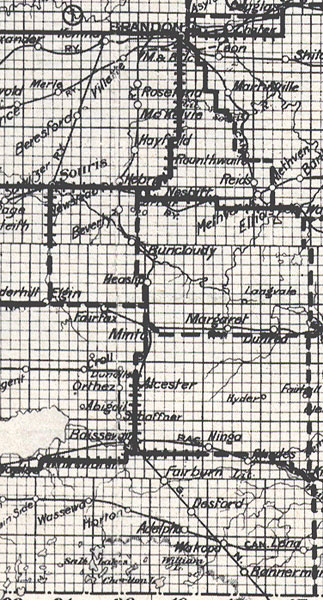
|
By 1930 a bridge
crossed the Souris
northeast of Heaslip
at the point now known as Riverside, and soon the present day Highway
#10
bypassed Hayfield and Bunclody.
The
depression worsened the situation and only
pressure from the government
kept it open until 1936 when the mail contract ended. It was simply not
a
viable enterprise, if it ever was. The tracks torn up in 1937 after
there
were no offer for the purchase of the line. The company formally
continued
to exist until Dec. 12. 1963 to allow for ongoing land transfers.
The
last train ran June 14, 1936. Stuckey
remembered with apparent fondness
the day when he and a friend waved to the engineer for the last time.
[26]
So ended a chapter in the region's
transportation
history. The line is credited
with ending the rural isolation felt by many Westman settlers and
offered
them an important time-saving travel option. Daytime shopping trips to
Brandon
were a treat, students at university could get home for weekends. But
the
car and the improved road conditions offered a new sense of freedom to
rural
residents, and the line, though remembered fondly by old-timers, was
just
not needed any longer.

Rail
lines in southwestern Manitoba. By 1914 virtually all farmers
were
now within 10 km. of an elevator. Withing another 20 years the age of
the auto would herald a new era, and many of the rail lines would
become unprofitable.
|

Bibliography
For more images - go to our
section on the BS&HB Communities
Todd, John, Jim Hill’s Canadian Railway, Canadian Rail No. 283, August
1975, Canadian Railroad Historical Association, Montreal
Download the
pdf..
Everitt, John, Kempthorne, Roberta, Scafer, Charles,
Controlled Aggression: James J. Hill and the Brandon, Saskatchewan and
Hudson’s Bay Railway, Brandon University, 1987, 7
Beckoning Hills Revisited : Ours is a Goodly Heritage,
Morton-Boissevain, 1881-1981, Boissevain History Committee, 1981
391, 523, 524, 593, 594
Minto Memoirs 1881-1979 : History of Minto and District, Minto and
District Historical Society, Inter-Collegiate Press. Winnipeg MB, 1979,
235, 42, 184,
Rose, D.F., Bunclody Community, 1879-1970, Bunclody Community, Carroll
MB.,1970
Memories of Hebron and Riverview, Riverview/Hebron Book Committee
|
|

